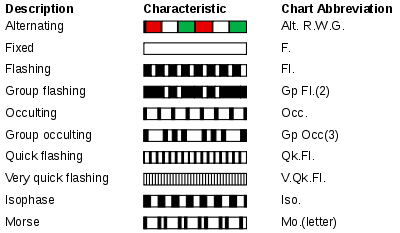- Light characteristic
-
Symbols and abbreviations for light characteristics 
A light characteristic is a graphic and text description of a navigational light sequence or colour displayed on a nautical chart or in a Light List with the chart symbol for a lighthouse, lightvessel, buoy or sea mark with a light on it. The graphic indicates how the real light beacon may be identified when looking at its actual light output type or sequence. Different lights use different colours, frequencies and light patterns, so mariners can find out which light they are seeing.
Contents
Abbreviations
While light characteristics can be described in prose, e.g. "Flashing white every three seconds", lists of lights use abbreviations. The abbreviation notation is slightly different from one light list to another, with dots added or removed, but it usually follow a pattern similar to the following (see the chart to the right for examples).
- An abbreviation of the type of light, e.g. "Fl." for flashing, "F." for fixed.
- The color of the light, e.g. "W" for white, "G" for green.
- The cycle period, e.g. "10s" for ten seconds.
- Additional parameters are sometimes added:
-
- The height of the light above the chart datum for height (usually based on high water). e.g. 15m for 15 metres.
- The range in which the light is visible, e.g. "10M" for 10 nautical miles.
An example of a complete light characteristic is "Gp Oc(3) W 10s 15m 10M". This indicates that the light is a group occulting light in which a group of three eclipses repeat every 10 seconds; the light is white; the light is 15 metres above the chart datum and is visible for 10 nautical miles (19 km).
Light patterns
Fixed light
A fixed light, abbreviated "F", is a continuous and steady light.
Flashing light
A flashing light is a rhythmic light in which the total duration of the light in each period is clearly shorter than the total duration of the darkness and in which the flashes of light are all of equal duration. It is most commonly used for a single-flashing light which exhibits only single flashes which are repeated at regular intervals, in which case it is abbreviated simply as "Fl". It can also be used with a group of flashes which are regularly repeated, in which case the abbreviation is "Fl.(2)" or "Gr Fl.(2)", for a group of two flashes. Another possibility is a composite group, in which successive groups in the period have different numbers of flashes, e.g. "Fl. (2+1)" indicates a group of two flashes, followed by one flash.
A specific case sometimes used[1] is when the flashes are longer than two seconds. Such a light is sometimes denoted "long flashing" with the abbreviation "L.Fl".
If the frequency of flashes is large (more than 30[2] or 50[1] per minute) the light is denoted as a "quick light", see below.
See also: Flashing headlightsOcculting light
An occulting light is a rhythmic light in which the total duration of light in each period is clearly longer than the total duration of darkness and in which the intervals of darkness (occultations) are all of equal duration. Like a flashing light, it can be used for a single occulting light that exhibits only single occultations which are repeated at regular intervals (abbreviated "Oc"), a group (Oc (3)) or a composite group (Oc (2+1)).
Isophase light
An isophase light, abbreviated "Iso", is a light which has dark and light periods of equal length. The prefix derives from the Greek iso- meaning "same".
Quick light
A quick light, abbreviated "Q", is a special case of a flashing light with a large frequency (more than 30[2] or 50[1] per minute). If the sequence of flashes is interrupted by regularly repeated eclipses of constant and long duration, the light is denoted "interrupted quick", abbreviated "I.Q".
Group notation similar to flashing and occulting lights is also sometimes[1] used (e.g. Q.(9)).
Another distinction sometimes[1] made is between quick (more than 50 and less than 80 flashes per minute), very quick (more than 80 and less than 160 flashes per minutes, abbreviated "V.Q") and ultra quick (no less than 160 flashes per minute, abbreviate "U.Q"). This can be combined with notations for interruptions, e.g. I.U.Q. for interrupted ultra quick, or grouping, e.g. V.Q.(9) for a very quick group of nine flashes. Quick characteristics can also be followed by other characteristics, e.g. V.Q.(6)+L.Fl. for a very quick group of six flashes, followed by a long flash.
Morse code
A Morse code light is light in which appearances of light of two clearly different durations (dots and dashes) are grouped to represent a character or characters in the Morse Code. For example, "Mo. (A)" is a light in which in each period light is shown for a short period (dot) followed by a long period (dash), the Morse Code for "A".
Fixed and flashing
A fixed and flashing light, abbreviated "F. Fl", is a light in which a fixed low intensity light is combined with a flashing high intensity light.
Alternating
An alternating light, abbreviate "Al", is a light which shows alternating colors. For example "Al WGB" show white, green and blue lights alternatively.
See also
Notes
References
- Light List, Volumes 1-7. United States Coast Guard. http://www.navcen.uscg.gov/?pageName=lightLists. - Glossary to Aids of Navigation Terms in any of the volumes
- Limits of List of Lights, Pubs. 110-116. United States National Geospatial-Intelligence Agency. http://msi.nga.mil/MSISiteContent/StaticFiles/Images/LOLlimits.jpg. p. XII - Characteristics of Lights, in any of the volumes
- Glossary of Lighthouse Terms
External links
Categories:
Wikimedia Foundation. 2010.
